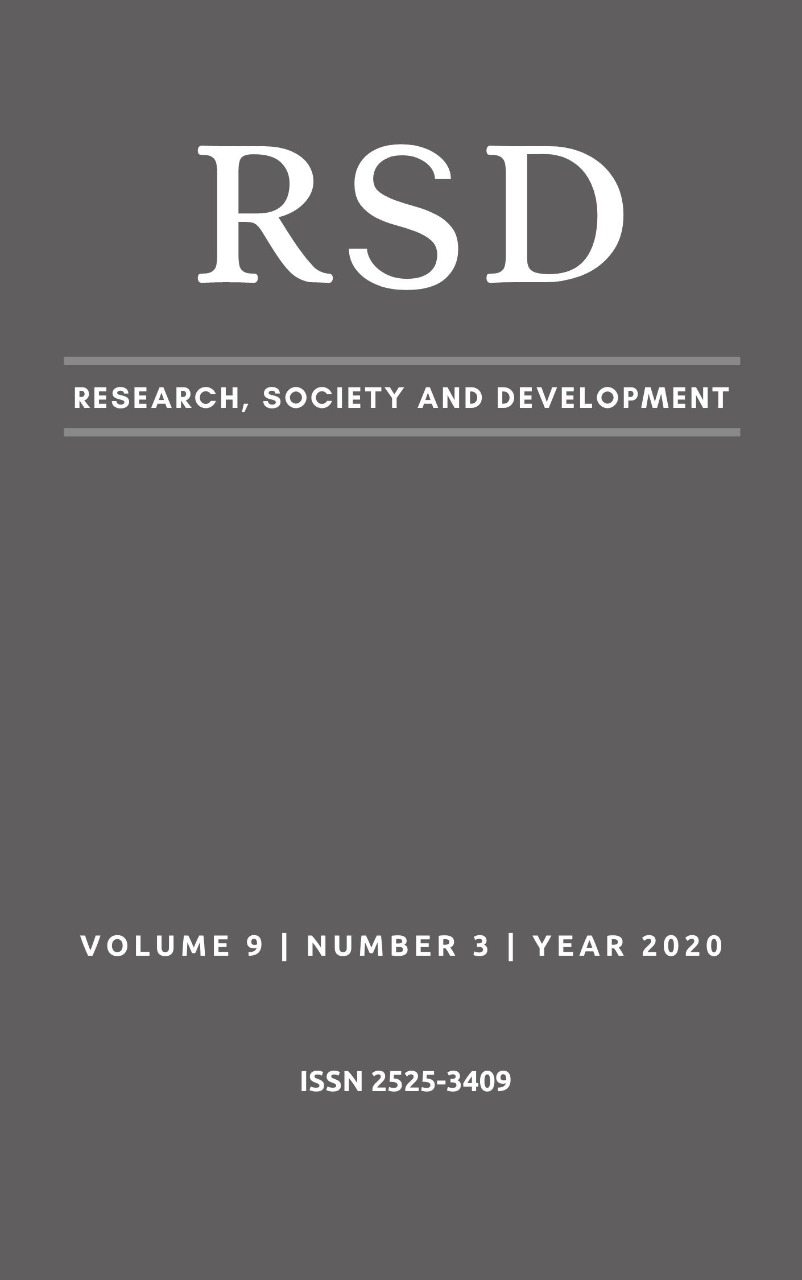A erosão dentária é um problema!
DOI:
https://doi.org/10.33448/rsd-v9i3.2723Palavras-chave:
Erosão dentária; Odontopediatria; Desgaste dos dentes.Resumo
A erosão dentária ou desgaste dentário erosivo é considerado um problema de saúde bucal contemporâneo, causado por processos químicos de “agressões ácidas” ao dente, sem o envolvimento bacteriano, que provoca a perda da sua estrutura mineral. Este problema ocorre em uma condição multifatorial, podendo haver a interação entre os fatores biológicos, químicos e comportamentais. Nos últimos anos a sua prevalência tem aumentado, tornando-a um desafio para os cirurgiões-dentistas, especialmente quando ela alcança estágios mais avançados aonde pode causar dor, hipersensibilidade, problemas com função e estética. Através de uma revisão da literatura, o presente estudo tem como objetivo orientar os cirurgiões-dentistas com informações a respeito da história, etiologia, diagnóstico, prevenção e tratamento do desgaste dentário erosivo. O conhecimento sobre os fatores etiológicos do desgaste dentário erosivo torna-se importante para evitar a progressão deste problema, além de estabelecer medidas preventivas eficazes desde a infância. O cirurgião-dentista deve realizar o diagnóstico precoce e realizar o tratamento adequado deste problema, sendo principalmente as orientações referentes à alimentação e higiene bucal além das terapias com flúor.
Referências
Bartlett D, Ganss C, Lussi A. Basic Erosive Wear Examination (BEWE): a new scoring system for scientific and clinical needs. Clin Oral Invest, 2008;12(Suppl.1), 65-68.
Bartlett D, O'Toole S. Tooth wear and aging. Aust Dent J, 2019;64(1), 59-62.
Buzalaf M.A, Hanna S.A.R, Kato M.T. Saliva and dental erosion. J Appl Oral Sci., 2012; 20(5), 493-502.
Carvalho T.S, Baumann T, Lussi A. Does erosion progress differently on teeth already presenting clinical signs of erosive tooth wear than on sound teeth? An in vitro pilot trial. BMC Oral Health, 2016;17(1), 262-78.
Ganss C, Lussi A. Diagnosis of erosive tooth wear. Monogr Oral Sci, 2014; 25, 22-31.
Hannas A.R, Kato M.T, Cardoso C.A, Magalhães A.C, Pereira J.C, Tjaderhane L, Buzalaf M.A. Preventive effect of tooth pastes with MMP inibitors on human dentine erosion and abrasion in vivo. J Appl Oral Sci, 2016; 24(1), 61-66.
Hara A.T, Zero D.T. The potential of saliva in protecting against dental erosion.Monogr Oral Sci, 2014;25,197-205.
Hellwig E, Lussi A. Oral hygiene products, medications and drugs - hidden aetiological factors for dental erosion.Monogr Oral Sci, 2014;25,155-62.
Hermont A.P, Oliveira P.A, Martins C.C, Paiva S.M, Pordeus I.A, Auad S.M. Tooth erosion and eating disorders: a systematic review and meta-analysis. PLoS One, 2014; 9(11), 221-227.
Honório H.M, Rios D, Santos C.F, Buzalaf M.A, Machado M.A. Influence of dental plaque on human enamel erosion: in situ / ex vivo study. Oral Health Prev. Dent, 2010; 8(2), 179-84.
Huysmans M.C., Young A., Ganss C. The role of fluoride in erosion therapy. Monogr Oral Sci, 2014; 25, 230-243.
Kanzow P, Wegehaupt F.J, Attin T, Wiegand A. Etiology and pathogenesis of dental erosion. Quintessence Int, 2016; 47(4),275-8.
Körner P, Wiedemeier D.B, Attin T, Wegehaupt F.J. Prevention of Enamel Softening by Rinsing with a Calcium Solution before Dental Erosion. Caries Res, 2020; (7), 1-7.
Li H, Zou Y, Ding G. Dietary factors associated with dental erosion: a meta-analysis. PLoS One, 2012; 7(8), 200-217.
Lussi A, Jaeggi T. Erosion-diagnosis and risk factors. Clin Oral Investig, 2008;12(1), S5-13.
Lussi A, Schlueter N, Rakhmatullina E, Ganss C. Dental erosion – An overview with emphasis on chemical and histopathological aspects. Caries Res, 2011;45(1),2-12.
Marró M.L, Aránguiz V, Ramirez V, Lussi A. Prevalence of erosive tooth wear in Chilean adults, 2016: A cross-sectional study. J Oral Rehabil. 2019.
Marsicano J.A, de Moura-Grec P.G, Bonato R.C, Sales-Peres M.C, Sales-Peres A, Sales-Peres S.H. Gastroesophageal reflux, dental erosion, and halitosis in epidemiological surveys: a systematic review. Eur J Gastroenterol Hepatol, 2013; 25(2), 135-41.
Martínez L.M, Menéndez A.M.L, Llop M.R, Ortells C.S, Aiuto R, Garcovich D. Dental erosion. Etiologic factors in a sample of Valencian children and adolescents. Cross-sectional study. Eur J Paediatr Dent, 2019;20,189-93.
Murakami C, Tello G, Abanto J, Oliveira L.B, Bonini G.C, Bönecker M. Trends in the prevalence of erosive tooth wear in Brazilian preschool children. Int J Paediatr Dent, 2016, 26(1), 60-65.
Racki D.N.O, Dalla Nora Â, Comim L.D, Zenkner J.E.D.A, Alves L.S. Erosive tooth wear among South Brazilian adolescents, and its association with sociodemographic variables. Braz Oral Res, 2020 Jan 10;33:e119.
Salas M.M, Nascimento G.G, Huysmans M.C, Demarco F.F. Estimated prevalence of erosive tooth wear in permanent teeth of children and adolescentes: an epidemiological systematic eview and meta-regression analysis. J Dent, 2015; 43(1),42-50.
Schlueter N, Jaeggi T, Lussi A. Is dental erosion really a problem? Adv Dent Res, 2012; 24(2), 68-71.
Shitsuka C, Mendes F.M, Corrêa M.S, Leite M.F. Exploring some aspects associated with dentine hypersensitivity in children. Scientific World Journal. 2015.
Waterhouse P.J, Auad S.M, Nunn J.H, Steen I.N, Moynihan P.J. Diet and dental erosion in young people in southeast Brazil. Int J Paediatric Dent, 2008;18, 353-60.
Zero D.T, Lussi A. Erosion: chemical and biological factors of importance to the dental practitioner. Int Dent Jour, 2005;55(4), 285-90.
Downloads
Publicado
Como Citar
Edição
Seção
Licença
Autores que publicam nesta revista concordam com os seguintes termos:
1) Autores mantém os direitos autorais e concedem à revista o direito de primeira publicação, com o trabalho simultaneamente licenciado sob a Licença Creative Commons Attribution que permite o compartilhamento do trabalho com reconhecimento da autoria e publicação inicial nesta revista.
2) Autores têm autorização para assumir contratos adicionais separadamente, para distribuição não-exclusiva da versão do trabalho publicada nesta revista (ex.: publicar em repositório institucional ou como capítulo de livro), com reconhecimento de autoria e publicação inicial nesta revista.
3) Autores têm permissão e são estimulados a publicar e distribuir seu trabalho online (ex.: em repositórios institucionais ou na sua página pessoal) a qualquer ponto antes ou durante o processo editorial, já que isso pode gerar alterações produtivas, bem como aumentar o impacto e a citação do trabalho publicado.

